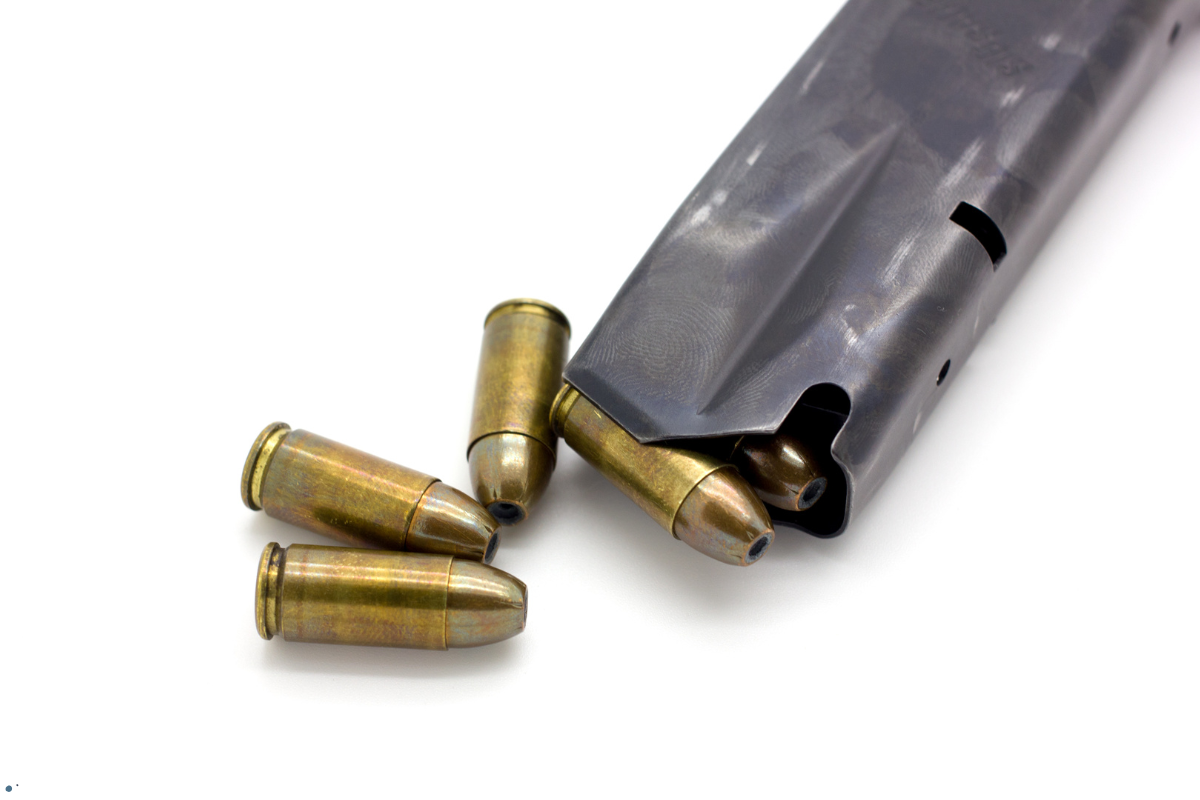
Firearm Magazine Restrictions and Capacity by State
Comprehensive guide to state-by-state magazine capacity restrictions, including current laws, legal challenges, and practical implications for gun owners navigating varying regulations across the United States.
Ship Restrict Team
Updated on May 9, 2025
In the complex landscape of U.S. gun laws, magazine capacity restrictions represent one of the most varied and frequently changing aspects of firearm regulation. These laws limit the number of rounds a magazine can legally hold, with significant differences from state to state. For gun owners, especially those who travel across state lines, understanding these restrictions is not just important—it's essential for legal compliance and avoiding potential criminal charges.
Understanding Magazine Capacity Laws
Magazine capacity restrictions limit the number of ammunition rounds that can be held in a single magazine. Proponents argue these laws reduce casualties in mass shootings by forcing more frequent reloads, while opponents contend they infringe on Second Amendment rights without meaningfully reducing crime.

Currently, 14 states plus the District of Columbia have enacted magazine capacity restrictions, while 36 states have no statewide limits. The restrictions that do exist vary significantly in their details, enforcement mechanisms, and exemptions.
States with Magazine Capacity Restrictions
California (10-Round Limit)

California maintains one of the nation's strictest magazine capacity laws, prohibiting the manufacture, importation, sale, transfer, and possession of any large-capacity magazine (defined as accepting more than 10 rounds).
The state's magazine restrictions have faced numerous legal challenges. In 2023, a federal court initially struck down the ban, but the 9th Circuit Court of Appeals reinstated it pending further review. In March 2023, the 9th Circuit upheld California's ban, finding it constitutional under the Second Amendment.
California's law includes no grandfather provision for magazines acquired before the ban, requiring owners to dispose of, permanently modify, or surrender non-compliant magazines.
Colorado (15-Round Limit)

Colorado prohibits the sale, transfer, and possession of magazines capable of accepting more than 15 rounds. Unlike California, Colorado includes a grandfather clause allowing continued possession of magazines owned prior to July 1, 2013, when the law took effect.
The law has survived legal challenges, including a notable case where the National Association for Gun Rights withdrew their challenge after complications involving research data from the National Shooting Sports Foundation.
Connecticut (10-Round Limit)

Connecticut bans magazines capable of accepting more than 10 rounds, with a partial grandfather provision. Residents who possessed large-capacity magazines before April 4, 2013, were required to register them with the state by January 1, 2014. Registered magazines may only be possessed at the owner's home, a shooting range, or while attending a firearms exhibition.
Delaware (17-Round Limit)

Delaware stands out with a higher capacity limit than most restricted states, prohibiting magazines that can accept more than 17 rounds. The law includes exemptions for:
- Active and retired law enforcement officers
- Concealed carry permit holders
- Firearms dealers and manufacturers
Hawaii (10-Round Limit for Handguns Only)

Hawaii takes a unique approach by restricting only handgun magazines to 10 rounds, with no restrictions on rifle magazines. This contrasts with most other states that either restrict all firearms or none.
Illinois (10/15-Round Limit)

Illinois enacted a tiered restriction system in 2023, limiting rifle magazines to 10 rounds and handgun magazines to 15 rounds. The law includes limited exemptions and allows possession of pre-ban magazines only at shooting ranges or on private property with the owner's consent.
Maryland (10-Round Limit)

Maryland prohibits the manufacture, sale, offer for sale, purchase, receipt, or transfer of magazines with capacities exceeding 10 rounds. However, the state does not criminalize mere possession of large-capacity magazines, creating an unusual situation where residents cannot acquire new large-capacity magazines but can keep those they already own.
Massachusetts (10-Round Limit)

Massachusetts prohibits large-capacity feeding devices (defined as accepting more than 10 rounds) with exemptions for magazines manufactured before September 13, 1994. The state requires registration of pre-ban magazines.
New Jersey (10-Round Limit)

New Jersey prohibits the manufacture, transportation, shipment, sale, or disposal of magazines capable of holding more than 10 rounds. In 2018, the state reduced its previous limit from 15 rounds to the current 10-round restriction. The law survived a challenge in the 3rd Circuit Court of Appeals.
New York (10-Round Limit)

New York's SAFE Act prohibits possession of magazines capable of accepting more than 10 rounds. The law includes no grandfather provision for pre-ban magazines. Additionally, the law initially restricted loading more than 7 rounds in a 10-round magazine, but this provision was struck down by federal courts.
Oregon (10-Round Limit)

Oregon implemented a 10-round magazine capacity limit in 2022. The law prohibits manufacturing, importing, selling, transferring, or possessing magazines that can accept more than 10 rounds, with limited exceptions for current owners who may continue to possess them on private property, at shooting ranges, and while hunting.
Rhode Island (10-Round Limit)

Rhode Island prohibits the possession, sale, or transfer of any feeding device capable of accepting more than 10 rounds. The law, enacted in 2022, includes exemptions for law enforcement and military personnel.
Vermont (10/15-Round Limit)

Vermont employs a tiered system similar to Illinois, restricting rifle magazines to 10 rounds and handgun magazines to 15 rounds. The state allows continued possession of magazines owned before the law's effective date of April 11, 2018.
Washington (10-Round Limit)

Washington state prohibits the manufacture, importation, distribution, sale, or offer for sale of large-capacity magazines (over 10 rounds). The law was enacted in 2022 and allows continued possession of pre-ban magazines.
District of Columbia (10-Round Limit)

The District of Columbia prohibits possession of magazines capable of accepting more than 10 rounds, with no grandfather provisions or exemptions for pre-ban ownership.
States Without Magazine Restrictions
The remaining 36 states have no statewide restrictions on magazine capacity. These include:
Alabama, Alaska, Arizona, Arkansas, Florida, Georgia, Idaho, Indiana, Iowa, Kansas, Kentucky, Louisiana, Maine, Michigan, Minnesota, Mississippi, Missouri, Montana, Nebraska, Nevada, New Hampshire, New Mexico, North Carolina, North Dakota, Ohio, Oklahoma, Pennsylvania, South Carolina, South Dakota, Tennessee, Texas, Utah, Virginia, West Virginia, Wisconsin, and Wyoming.
However, gun owners should note that some local jurisdictions within these states may have their own restrictions. For example, Columbus, Ohio has a municipal ordinance limiting magazine capacity to 30 rounds.
Historical Context: Federal Assault Weapons Ban
The current patchwork of state laws emerged following the expiration of the Federal Assault Weapons Ban (1994-2004), which prohibited magazines capable of accepting more than 10 rounds nationwide. When the federal ban sunset in 2004, states began enacting their own restrictions.
According to an American Journal of Public Health study, states with large-capacity magazine bans experienced fewer high-fatality mass shootings during the study period. The researchers found that states with LCM bans had a 63% lower rate of high-fatality mass shootings compared to states without such restrictions.
Recent Legal Developments
Magazine capacity laws have faced numerous legal challenges, particularly following the Supreme Court's landmark decisions in District of Columbia v. Heller (2008) and New York State Rifle & Pistol Association v. Bruen (2022).
The Bruen decision established a new test for evaluating gun laws, requiring them to be consistent with the nation's historical tradition of firearm regulation. This has prompted fresh challenges to magazine restrictions nationwide.
Key recent developments include:
-
California: The 9th Circuit Court of Appeals upheld California's 10-round limit in 2023, finding it consistent with historical regulations on especially dangerous weapons.
-
Delaware: The state's 17-round limit, passed in 2022, represents a compromise approach that has so far avoided major legal challenges.
-
Oregon and Washington: Both states enacted 10-round limits in 2022, with legal challenges still pending.
Practical Implications for Gun Owners
Interstate Travel Considerations
Gun owners who travel between states face particular challenges with magazine restrictions. The federal Firearm Owners Protection Act provides limited protection during interstate travel, but does not shield travelers who stop in restricted states with non-compliant magazines.
For example, a traveler passing through New Jersey with a 15-round magazine (legal in their home state) could face second-degree felony charges carrying 5-10 years imprisonment if discovered.
Modification Options
Some gun owners in restricted states choose to modify existing magazines to comply with capacity limits. Common modification methods include:
- Installing blocking devices that limit the magazine's capacity
- Permanently altering the magazine body to reduce capacity
- Replacing standard magazines with commercially available compliant versions
However, states differ on what constitutes acceptable modification. California, for instance, requires "permanent alteration" that prevents the magazine from being readily restored to its original capacity.
Exemptions and Special Cases
Most states with magazine restrictions include exemptions for:
- Active law enforcement officers
- Military personnel acting in their official capacity
- Licensed firearms dealers (for sales to exempt individuals)
- Movie production companies (using props)
Some states also exempt retired law enforcement officers, competitive shooters, or firearms collectors, though the specifics vary significantly.
The Ongoing Debate
The debate over magazine capacity restrictions continues to evolve, with strong opinions on both sides.

Arguments for Restrictions
Proponents of magazine capacity limits argue:
- Forcing more frequent reloads in mass shooting scenarios creates intervention opportunities
- High-capacity magazines are not necessary for self-defense
- Historical precedent exists for regulating especially dangerous weapons
- Studies suggest reduced casualties in states with restrictions
Arguments Against Restrictions
Opponents counter that:
- Standard-capacity magazines are in common use, with millions in circulation
- The few seconds required to change magazines rarely affect outcomes
- Criminals will ignore magazine restrictions
- The restrictions burden law-abiding citizens without meaningfully reducing crime
Conclusion
Magazine capacity restrictions represent one of the most varied aspects of U.S. firearm regulation. The current landscape—14 states plus DC with restrictions and 36 states without—creates significant compliance challenges for gun owners, particularly those who travel interstate.
As legal challenges continue and state legislatures respond to both court decisions and public pressure, these laws will likely continue to evolve. Gun owners must stay informed about current restrictions in their state and any states they plan to visit to ensure legal compliance.
For the most current information on magazine restrictions in your area, consult with a qualified attorney who specializes in firearms law or check with state law enforcement agencies, as firearms laws can change rapidly and interpretation may vary.
Note: This article provides general information about magazine capacity laws and should not be considered legal advice. Laws change frequently, and this information may not reflect the most current legal developments. Always consult with a qualified attorney for specific legal guidance.

Cody Yurk
Founder and Lead Developer of ShipRestrict, helping e-commerce businesses navigate complex shipping regulations for regulated products. Ecommerce store owner turned developer.